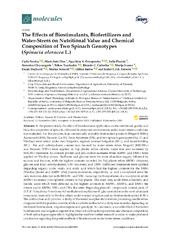Приказ основних података о документу
The Effects of Biostimulants, Biofertilizers and Water-Stress on Nutritional Value and Chemical Composition of Two Spinach Genotypes (Spinacia oleracea L.).
| dc.creator | Pereira, Carla | |
| dc.creator | Dias, Maria Inês | |
| dc.creator | Petropoulos, Spyridon A. | |
| dc.creator | Plexida, Sofia | |
| dc.creator | Chrysargyris, Antonios | |
| dc.creator | Tzortzakis, Nikos | |
| dc.creator | Calhelha, Ricardo C. | |
| dc.creator | Ivanov, Marija | |
| dc.creator | Stojković, Dejan | |
| dc.creator | Soković, Marina | |
| dc.creator | Barros, Lillian | |
| dc.creator | C F R Ferreira, Isabel | |
| dc.date.accessioned | 2020-01-10T12:42:21Z | |
| dc.date.available | 2020-01-10T12:42:21Z | |
| dc.date.issued | 2019 | |
| dc.identifier.issn | 1420-3049 | |
| dc.identifier.uri | https://www.mdpi.com/1420-3049/24/24/4494 | |
| dc.identifier.uri | https://radar.ibiss.bg.ac.rs/handle/123456789/3577 | |
| dc.description.abstract | In the present study, the effect of biostimulants application on the nutritional quality and bioactive properties of spinach cultivated in protected environment under water stress conditions was evaluated. For this purpose, four commercially available biostimulant products (Megafol (MEG), Aminovert (AM), Veramin Ca (V), Twin Antistress (TA), and two spinach genotypes (Fuji F1 and Viroflay) were tested under two irrigation regimes (normal irrigation (W+), and water-holding (W-). Fat and carbohydrates content was favored by water stress when Megafol (MEGW+) and Veramin (VW+) were applied on Fuji plants, while calorific value was also increased by MEGW+ treatment. In contrast, protein and ash content increased when AMW- and TAW+ were applied on Viroflay plants. Raffinose and glucose were the most abundant sugars, followed by sucrose and fructose, with the highest contents recorded for Fuji plants when AMW+ (fructose, glucose and total carbohydrates), CW- (sucrose), and TAW- (raffinose) treatments were applied. Regarding organic acids, oxalic and malic acid which had the highest contents for the TAW- (Viroflay plants) and AMW- (Fuji plants) treatments, respectively. α- and γ-tocopherol were the only isoforms detected with MEGW- and VW- inducing the biosynthesis of α-tocopherol, while AMW+ increased γ-tocopherol content in Fuji plants. The main fatty acids were α-linolenic and linoleic acids which were detected in the highest amounts in AMW-, AMW+, and TAW+ the former and in AMW-, VW-, and CW+ the latter. Regarding phenolic compounds content, peak 12 (5,3',4'-Trihydroxy-3-methoxy-6:7-methylenedioxyflavone-4'-glucuronide) was the most abundant compound, especially in Viroflay plants under normal irrigation and no biostimulants added (CW-). The antioxidant and cytotoxic activity of the tested samples did not show promising results when compared with the positive controls, while a variable antibacterial activity was recorded depending on the tested biostimulant, irrigation regime and genotype. In conclusion, a variable effect of the tested biostimulants and irrigation regimes was observed on bioactive properties and chemical composition of both spinach genotypes which highlights the need for further research in order to make profound conclusions regarding the positive effects of biostimulants under water stress conditions. | en |
| dc.publisher | Multidisciplinary Digital Publishing Institute | |
| dc.relation | Foundation for Science and Technology (FCT, Portugal) | |
| dc.relation | FEDER under Programme PT2020 | |
| dc.relation | 0377_Iberphenol_6_E | |
| dc.relation | TRANSCoLAB 0612_TRANS_CO_LAB_2_P | |
| dc.rights | openAccess | |
| dc.rights.uri | https://creativecommons.org/licenses/by/4.0/ | |
| dc.source | Molecules (Basel, Switzerland) | |
| dc.subject | Spinacia oleracea L. | |
| dc.subject | Antimicrobial properties | |
| dc.subject | Antioxidant activities | |
| dc.subject | Bioactive properties | |
| dc.subject | Biostimulants | |
| dc.subject | Oxalic acid | |
| dc.subject | Phenolic compounds | |
| dc.subject | Spinach | |
| dc.subject | Tocopherols | |
| dc.subject | Water stress | |
| dc.title | The Effects of Biostimulants, Biofertilizers and Water-Stress on Nutritional Value and Chemical Composition of Two Spinach Genotypes (Spinacia oleracea L.). | en |
| dc.type | article | en |
| dc.rights.license | BY | |
| dcterms.abstract | Переира, Царла; Иванов, Марија; Цхрyсаргyрис, Aнтониос; Плеxида, Софиа; Стојковић, Дејан; Диас, Мариа Инêс; Петропоулос, Спyридон A.; Тзортзакис, Никос; Цалхелха, Рицардо Ц.; Соковић, Марина; Баррос, Лиллиан; Ц Ф Р Ферреира, Исабел; | |
| dc.rights.holder | © 2019 by the authors. | |
| dc.citation.issue | 24 | |
| dc.citation.volume | 24 | |
| dc.identifier.doi | 10.3390/molecules24244494 | |
| dc.identifier.pmid | 31817970 | |
| dc.identifier.scopus | 2-s2.0-85076359699 | |
| dc.identifier.wos | 000507299600072 | |
| dc.citation.apa | Pereira, C., Dias, M. I., Petropoulos, S. A., Plexida, S., Chrysargyris, A., Tzortzakis, N., et al. (2019). The Effects of Biostimulants, Biofertilizers and Water-Stress on Nutritional Value and Chemical Composition of Two Spinach Genotypes (Spinacia oleracea L.). Molecules (Basel, Switzerland), 24(24), 4494. | |
| dc.citation.vancouver | Pereira C, Dias MI, Petropoulos SA, Plexida S, Chrysargyris A, Tzortzakis N, Calhelha RC, Ivanov M, Stojković D, Soković M, Barros L, C F R Ferreira I. The Effects of Biostimulants, Biofertilizers and Water-Stress on Nutritional Value and Chemical Composition of Two Spinach Genotypes (Spinacia oleracea L.). Molecules. 2019;24(24):4494. | |
| dc.citation.spage | 4494 | |
| dc.type.version | publishedVersion | |
| dc.identifier.fulltext | https://radar.ibiss.bg.ac.rs/bitstream/id/5865/molecules-24-04494.pdf | |
| dc.citation.rank | M22 |

